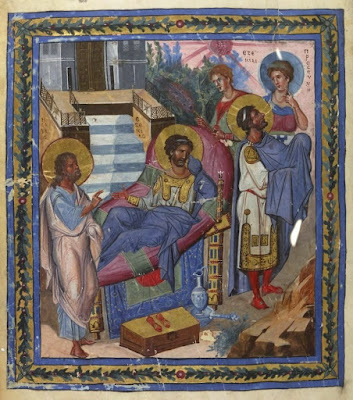The Paris Psalter
Since I used a rather plain page of the Paris Psalter to illustrate an article last week, I thought it would be a good idea to take a look at the images which have made it one of the most famous illuminated manuscripts of all time. It was produced at Constantinople in the mid-10th century, the heart of the era which Byzantine scholars often call the “Macedonian Renaissance,” under the emperors of the Macedonian dynasty (867-1055). The first of these, Basil I, came to power just twenty years after the final defeat in 847 of the Iconoclast heresy, the wake of which saw a strong reaction in favor of copying, and thus preserving, works of fthe pre-iconoclast Greco-Roman tradition. This classicizing tendency is particularly notable in the 10th century, when the revival of both the visual and literary arts was flourishing in Constantinople.Many of the details in these images, especially the buildings in the backgrounds, but also the manner of representing the clothes, are strongly reminiscent of the wall-paintings in Pompei. The renewed interest in ancient classical models is evident in the very first image, where King David looks very much like ancient representations of Orpheus as he plays the harp, surrounded, like Orpheus, by wild animals. In the upper left hand corner we see the city of Bethlehem; the woman against whom David leans is the personification of Melody, another very Greco-Roman artistic idea. The red figure in the lower right hand corner is the “mountain of Bethlehem.”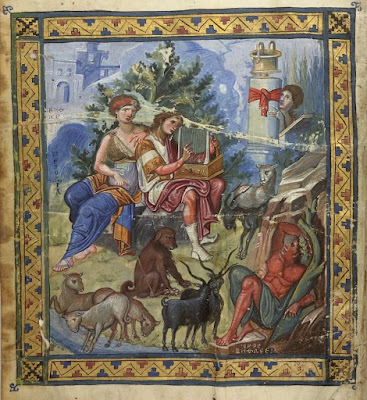 The second image, unfortunately rather damaged, shows David defending his flock from a lion, with a dead bear he has already killed at the bottom, as stated in 1 Kings 17. 34, assisted by the personification of Strength.
The second image, unfortunately rather damaged, shows David defending his flock from a lion, with a dead bear he has already killed at the bottom, as stated in 1 Kings 17. 34, assisted by the personification of Strength.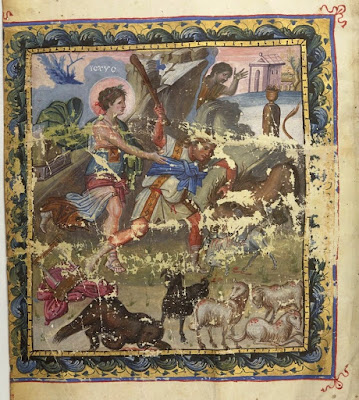 The third shows David being anointing by Samuel, surrounded by his father and brothers, with the personification of Meekness above him. (1 Kings 16)
The third shows David being anointing by Samuel, surrounded by his father and brothers, with the personification of Meekness above him. (1 Kings 16)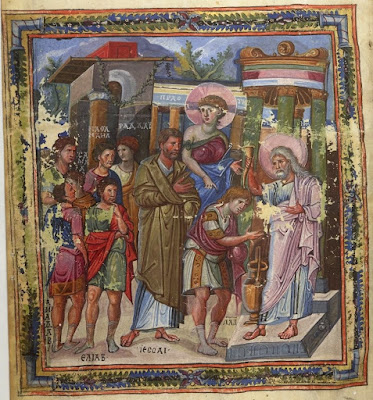 In the upper register of the fourth image, David, accompanied by the personification of Force, fights Goliath, as the personification of Boastfulness flees; in the lower register, the Israelite and Philistine armies face off as David decapitates Goliath. (1 Kings 17)
In the upper register of the fourth image, David, accompanied by the personification of Force, fights Goliath, as the personification of Boastfulness flees; in the lower register, the Israelite and Philistine armies face off as David decapitates Goliath. (1 Kings 17)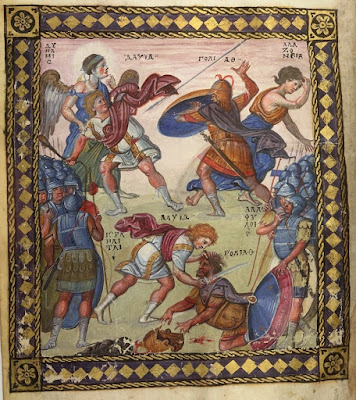 The fifth image is a good example of a late Roman artistic convention by which halos are used to indicate the most important figure, in this case King Saul, without reference to goodness or holiness. The caption in the upper left gives the words of the daughters of Israel, (one of whom dances in the foreground in celebration,) which provoke Saul’s jealousy of David, “Saul hath slain a thousand, and David ten thousand.” (1 Kings 18, 7)
The fifth image is a good example of a late Roman artistic convention by which halos are used to indicate the most important figure, in this case King Saul, without reference to goodness or holiness. The caption in the upper left gives the words of the daughters of Israel, (one of whom dances in the foreground in celebration,) which provoke Saul’s jealousy of David, “Saul hath slain a thousand, and David ten thousand.” (1 Kings 18, 7) The sixth shows the coronation of David by an unlabeled female figure, whose halo indicates that she is another personification.
The sixth shows the coronation of David by an unlabeled female figure, whose halo indicates that she is another personification.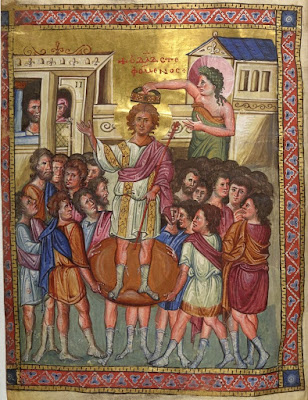 The last of this opening series, all of which are placed in the manuscript before the Psalter itself begins, shows King David as an older man, with Wisdom to the left, Prophecy to the right, and the dove of the Holy Spirit above his head. On the book in his hands is the beginning of Psalm 71, long read as a prophecy of the coming of the Messiah because of the words “And he shall rule from sea to sea, and from the river unto the ends of the earth”; it is traditionally sung on both Christmas and Epiphany.
The last of this opening series, all of which are placed in the manuscript before the Psalter itself begins, shows King David as an older man, with Wisdom to the left, Prophecy to the right, and the dove of the Holy Spirit above his head. On the book in his hands is the beginning of Psalm 71, long read as a prophecy of the coming of the Messiah because of the words “And he shall rule from sea to sea, and from the river unto the ends of the earth”; it is traditionally sung on both Christmas and Epiphany.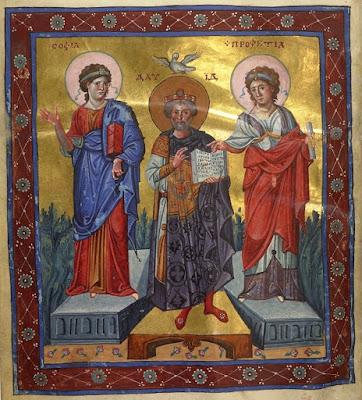 The next image occurs 130 folios later, before Psalm 50, the penitential psalm par excellence, representing the episode which, according to the title of that Psalm, led to its composition, “when the Prophet Nathan came to him after he had gone in to Bathsheba.” (2 Kings 11-12) David is represented with a beard, older than he was in the earlier miniatures, again in accordance with Roman conventions. In the upper right, the hands of the personification of Repentance indicate contemplation, as in many Roman statues, as David prostrates himself below her.
The next image occurs 130 folios later, before Psalm 50, the penitential psalm par excellence, representing the episode which, according to the title of that Psalm, led to its composition, “when the Prophet Nathan came to him after he had gone in to Bathsheba.” (2 Kings 11-12) David is represented with a beard, older than he was in the earlier miniatures, again in accordance with Roman conventions. In the upper right, the hands of the personification of Repentance indicate contemplation, as in many Roman statues, as David prostrates himself below her.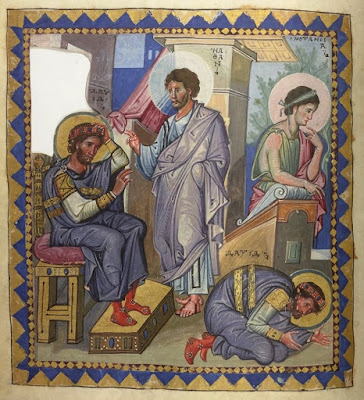 After 283 more folios, there begins a series of images which illustrate some of the Old Testament canticles of Byzantine Lauds. (In practice, these are almost never sung today, being replaced by a series of poetic compositions called a Canon.) The first of these is the Canticle of Moses in Exodus, chapter 15, 1-19, at the crossing of the Red Sea. The upper register shows the personifications of Night and of the Desert, out of which Moses leads the Israelites as he strikes the water with his rod, led by the column of fire. In the lower register, the nude personification of the Deep (here a male, since the Greek word ‘Bythos’ is masculine), looking very much like a classical statue, drags Pharaoh down into the water, as the personification of the Red Sea looks on from the lower right-hand corner.
After 283 more folios, there begins a series of images which illustrate some of the Old Testament canticles of Byzantine Lauds. (In practice, these are almost never sung today, being replaced by a series of poetic compositions called a Canon.) The first of these is the Canticle of Moses in Exodus, chapter 15, 1-19, at the crossing of the Red Sea. The upper register shows the personifications of Night and of the Desert, out of which Moses leads the Israelites as he strikes the water with his rod, led by the column of fire. In the lower register, the nude personification of the Deep (here a male, since the Greek word ‘Bythos’ is masculine), looking very much like a classical statue, drags Pharaoh down into the water, as the personification of the Red Sea looks on from the lower right-hand corner.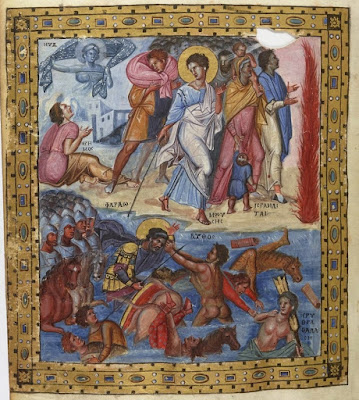 The second Ode, the canticle of Moses in Deuteronomy 32, 1-43, is only sung in Lent (and again, in modern practice routinely omitted.) Since the canticle is mostly about the failure of the children of Israel to keep the Law, the accompanying image is of the revelation of the Law to Moses on Mount Sinai (Exodus 19 et seqq.), personified in the lower left as a red figure, like the “mountain of Bethlehem” in the first image.
The second Ode, the canticle of Moses in Deuteronomy 32, 1-43, is only sung in Lent (and again, in modern practice routinely omitted.) Since the canticle is mostly about the failure of the children of Israel to keep the Law, the accompanying image is of the revelation of the Law to Moses on Mount Sinai (Exodus 19 et seqq.), personified in the lower left as a red figure, like the “mountain of Bethlehem” in the first image.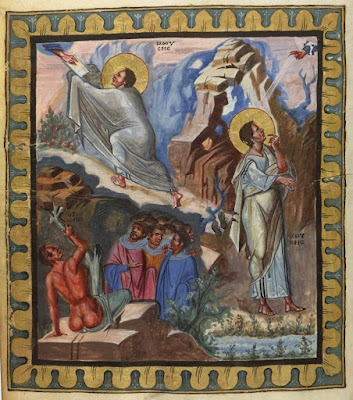 The canticle of Anna (1 Kings 2, 1-10), which is sometimes called the Magnificat of the Old Testament, is preceded by this image which might easily be mistaken for one of the Virgin Mary.
The canticle of Anna (1 Kings 2, 1-10), which is sometimes called the Magnificat of the Old Testament, is preceded by this image which might easily be mistaken for one of the Virgin Mary.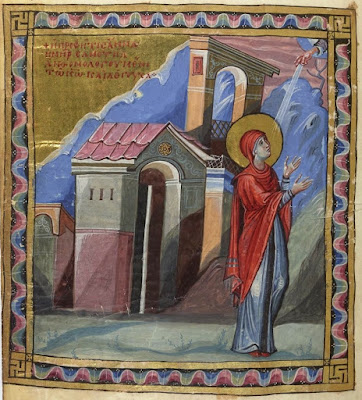 The canticle of Jonah (chapter 2, 3-10) is preceded by an image which covers each of the four chapters of his book: Jonah being thrown out of the boat (chapter 1); Jonah spat out of the whale (chapter 2), here shown as a sea-monster; Jonah preaching to the Ninivites (chapter 3) and speaking with God (chapter 4.) This canticle is not used in the Roman Rite, but is sung at Sunday Matins from Easter to mid-October in the Ambrosian Rite, which also reads the entire book at the Mass of the Lord’s Supper; in the Byzantine Rite, the whole book is read at the Easter vigil.
The canticle of Jonah (chapter 2, 3-10) is preceded by an image which covers each of the four chapters of his book: Jonah being thrown out of the boat (chapter 1); Jonah spat out of the whale (chapter 2), here shown as a sea-monster; Jonah preaching to the Ninivites (chapter 3) and speaking with God (chapter 4.) This canticle is not used in the Roman Rite, but is sung at Sunday Matins from Easter to mid-October in the Ambrosian Rite, which also reads the entire book at the Mass of the Lord’s Supper; in the Byzantine Rite, the whole book is read at the Easter vigil.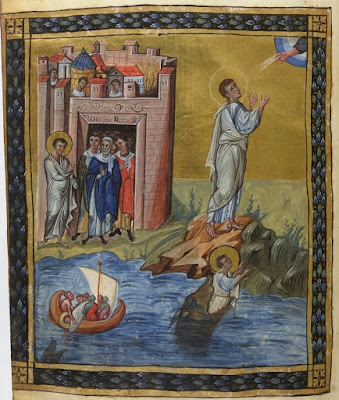 In this image of the Prophet Isaiah, the personifications of Night (Nyx) and Morning (Orthros, also Greek word for Lauds) are inspired by the first words of the canticle taken from chapter 26 of his book, verses 9-20. “ek nyktos orthrizei - out of the night my souls riseth early to seek thee.”
In this image of the Prophet Isaiah, the personifications of Night (Nyx) and Morning (Orthros, also Greek word for Lauds) are inspired by the first words of the canticle taken from chapter 26 of his book, verses 9-20. “ek nyktos orthrizei - out of the night my souls riseth early to seek thee.”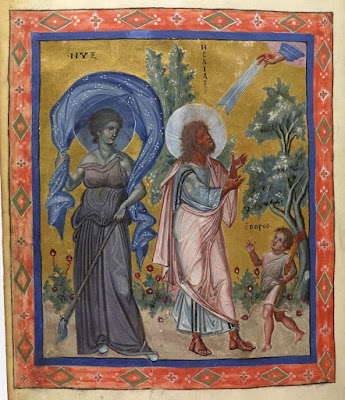 The last image is placed before the canticle of King Ezechiah in Isaiah 38, 10-20, which is sung in the Roman Rite on Tuesday Lauds and in the Office of the Dead. It is included in many early Byzantine Psalters, even though it is not used liturgically. The figure at the upper right is the personification of Prayer.
The last image is placed before the canticle of King Ezechiah in Isaiah 38, 10-20, which is sung in the Roman Rite on Tuesday Lauds and in the Office of the Dead. It is included in many early Byzantine Psalters, even though it is not used liturgically. The figure at the upper right is the personification of Prayer.